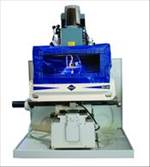How to Navigate New Horizons with Waterjet
Expand capabilities and diversify customer base with waterjet technology.
In the past decade or so, U.S. moldmakers have grappled with significant economic and business challenges. These include a more prominent and competitive global landscape, skilled labor shortages, raw material costs and tighter timelines. These challenges have forced moldmakers to find new ways to combat a shrinking market and declining profits. Companies are staying competitive by evolving with automation, streamlined processes and new technologies.
With the addition of waterjet, moldmakers can expand their capabilities and diversify their customer base. Waterjet is one of the most versatile manufacturing technologies today. It uses a high-pressure stream of water with an abrasive, such as garnet, to cut. And unlike many other alternative cutting processes, waterjet can cut virtually any material—including glass, ceramic, wood, stone, plastic and rubber.
A Mental Shift
As moldmakers, we have developed the instinct for process and production that delivers superior accuracy, quality and precision. EDM is a precise machining method used to remove material from the workpiece, producing a blind cavity. Its fuzzy logic technology responds to minor changes in machining conditions, delivering sub-micron finishes. Sinker EDM’s low-pressure flushing allows for production of very thin sections and fine finishes.
In contrast, the fast and flexible waterjet is not known for precision or fine finishes. However, when EDM and advanced waterjet technologies are paired up, this odd couple can lead to improved productivity and higher profits.
What waterjet lacks in precision, it makes up in speed. Top shops are recognizing the opportunity and incorporating this unlikely technology into their moldmaking facilities. Advanced waterjet technology is ideal for cutting production times attached to roughing and bulk material removal before finishing on an EDM.
Some advanced waterjets combine the speed and flexibility of waterjet with superior programming and drive system capabilities to complement the EDM process. A taper compensation design allows for tilt and rotation of the jet to maintain maximum speed with accurate wall straightness. It uses a one- to two-degree mechanical tilt to compensate for the jet getting wider as it exits the focus tube, maintaining stream velocity and providing wall straightness other waterjet systems cannot achieve.
For the Sake of Diversity
Beyond this new cost-effective and productive approach to the traditional mold process, waterjet adds a huge versatility factor to a shop’s capabilities. Waterjet is the stepping stone that gets moldmakers and other niche manufacturers outside of their box, and positioned to broaden their customer base and recruit new business.
If diversification is the main motivator for considering waterjet, an advanced series might not be necessary. A new entry-level production waterjet can help open the door to big opportunities and new revenue streams. Plus, its solid base construction and cantilever head design make it both reliable and affordable. While it lacks some of the advanced series functions and capabilities that complement the EDM process, it is a fast, durable and cost-effective way to stimulate new opportunities and open a shop’s doors to new markets.
Related Content
-
Leading Mold Manufacturers Share Best Practices for Improving Efficiency
Precise Tooling Solutions, X-Cell Tool and Mold, M&M Tool and Mold, Ameritech Die & Mold, and Cavalier Tool & Manufacturing, sit down for a fast-paced Q&A focused on strategies for improving efficiencies across their operations.
-
OEE Monitoring System Addresses Root Cause of Machine Downtime
Unique sensor and patent-pending algorithm of the Amper machine analytics system measures current draw to quickly and inexpensively inform manufacturers which machines are down and why.
-
Machining Center Spindles: What You Need to Know
Why and how to research spindle technology before purchasing a machining center.







.jpg;maxWidth=300;quality=90)




